|
Schools
Independent School District No. 319 One of the
first concerns of Nashwauk's earliest settlers was formal
education. Independent School District No. 9 was organized
in June of 1903. The beginnings, though modest in numbers,
were ambitious in scope. As the numbers increased, the
buildings were enlarged or left in favor of more adequate
facilities. The school system grew steadily, rapidly adding
a kindergarten, a library, a high school, manual training
and domestic science, a music department, a night school and
athletics. Nashwauk left its mark statewide in areas such as
athletics (undefeated football teams 1926-1928 and 1952-54),
agriculture (winning state competitions), music (first high
school band not of the Twin Cities to attend the Minnesota
State Fair, 1916).
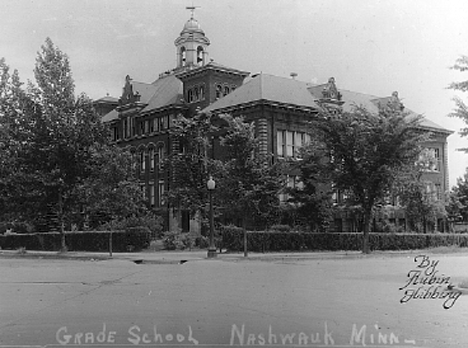
Grade School, Nashwauk Minnesota, around 1928
LakesnWoods.com Postcard and Postcard Image Collection In 1962-63
Nashwauk and Keewatin were once again consolidated into one
school district to share the burden of educating their
citizens as they had been when it all began in 1903. The
Nashwauk school system sent many of its sons and daughters
into the world well-prepared to pursue a wide variety of
professions. Due to the many and varied activities and
programs, the youngsters became well-rounded adults ready
and eager to take their place in a growing, bustling and
maturing society.
|
1903: |
Certificate of organization of Independent
School District No. 9 issued in June. 3 teachers
employed. School held in Nashwauk. |
|
1907: |
Kindergarten established in Nashwauk — Josephine Hill as
teacher. |
|
1908: |
$100
voted for library. Librarian hired to work 3 hours each
Friday at $15 per month. |
|
1908: |
Nashwauk High School work established with 3 pupils. |
|
1910: |
Manual training and domestic science instituted.
1915: School band formed with 42 pupils. |
|
1916: |
Night school established to hold sessions 3
nights a week. |
|
1923: |
Schools promoted to 4 year accredited high
school list |
|
1923-1947: |
Judd Gregor, Phy. Ed. instructor and coach —
fondly remembered by many of Nashwauk's
young men.
|
|
1926-1928: |
Nashwauk undefeated football team — coached by
Judd Gregor. |
|
1947-1973: |
Angelo Taddie took over the reigns from J.
Gregor as Athletic Director and coach. |
|
1952-1954: |
Nashwauk football team undefeated. Held record
for longest winning streak in the state at the
time — 20 games in a row. |
|
1962-1963: |
Nashwauk and Keewatin consolidate to form single
district. Class of 1963 first to graduate from
consolidated district. |
|
1975-1976: |
First AFS foreign exchange student, Miss Sissel
Lie (Norway) attended Nashwauk High School. |
| |
|
|
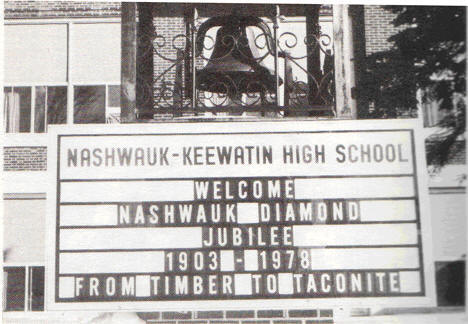 |
| This is the original school
bell that was salvaged from the Nashwauk Grade
School before it was demolished several years
ago. The bell is now permanently set in a brick
casing and stands in front of the
Nashwauk-Keewatin High School. The billboard in
the front is used to announce school activities. |
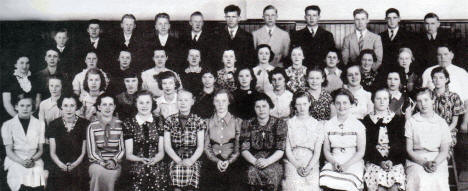
Nashwauk High School Mixed Chorus, 1936-1937

N-K High School Band — July 4, 1965
Churches
|
I AM THE CHURCH
In my Sanctuary there is
Peace for tired minds
Rest for weary bodies
Compassion for suffering humanity
Forgiveness for repentant sinners Communion for
Saints
CHRIST — for all who seek him! |
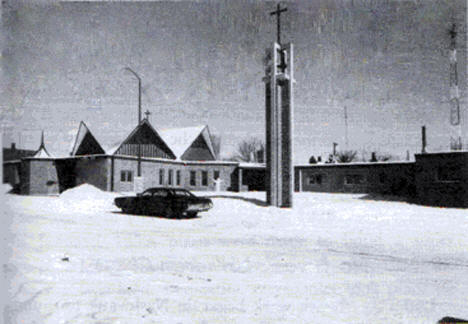
St. Cecilia's Catholic Church
St. Cecilia's Catholic Church
Immigrants
from Italy, Yugoslavia, Germany, France, Hungary and Poland
brought the Catholic faith with them to Nashwauk after the
turn of the century. Fathers Gamache, Zarilli, Kileen and
Larrigan first came from Hibbing and Coleraine to offer Mass
for the people in their homes and in the old school house
north of town beginning in 1905. Father
Quillien became the first resident pastor in 1910. During
the next year both men and women worked to build the first
Catholic Church in the town of Nashwauk. Father Gamache came
to live in Nashwauk in 1911 and a rectory was built for him
in 1916. In 1936 the church was enlarged and remodeled under
the direction of Father William Hennebry. The rectory was
modernized in 1953. In 1956
Mr. and Mrs. James Linsmayer donated the Hayes building to
the parish and also a catechetical center in Cloverdale.
About the same time the Men's Club raised funds to purchase
the chimes which were installed and serviced by Joe Ewen. Mrs.
McCullough taught catechism classes. Catharine Ryan was the
first organist when the church was built and after 1916 Mary
Margaret Ewen played the organ for nearly half a century. In
recent years Mrs. Herbert Specht directed the choir and
played the organ. Pat Specht and Kathy Young are now the
regular organists. Frances
Yetta and James Provinzino are some of the oldest living
members of St. Cecilia's parish. There is also Silvio
Brignolio, Frances Bolf, Glendora Metzer, and Julia Klayich
Rokich. Several priests of the Duluth diocese are originally
from St. Cecilia's parish: Fathers Francis Method, George
Schroeder, George Zeck and Tom Radaich. The former Mary
Elizabeth Ewen of Nashwauk is now Sister Ramona OSB at St.
Scholastica's in Duluth. Some of
the better known priests assigned to St. Cecilia's were
Fathers Austin Turbiaux (1922-1928), William Hennebry
(1933-1945), Henry Spain (1945-1949), Thomas Durkin
(1950-1960), John Dolsina (1960-1967), Thomas Stack
(1968-1972), and Rudolph Pakiz, the present pastor. Under
Father Dolsina the old church, rectory and Hayes building
were removed or demolished and in 1965 the new St. Cecilia's
Church, rectory, classrooms and Linsmayer Hall were built
and dedicated. The architect was McCann of Minneapolis and
the builders were Hofmann & Sons of Crosby. The parish hall
was named after James Linsmayer, an outstanding benefactor
of the parish, who left a foundation for its perpetual care
and maintenance. On
September 18 of 1960 the Golden Jubilee of the parish was
celebrated with an outdoor Mass at the high school stadium. In 1977
Father Rudolph Pakiz was made pastor of St. Kevin's in
Pengilly, in addition to being pastor at St. Cecilia's, and
three Franciscan Sisters from Little Falls moved into St.
Kevin's rectory to assist with pastoral ministry work in
both parishes. They are Sisters Mary Amy Schreiner, Bertha
Gerads and Janet Kunkel. In
addition to religious services, the St. Cecilia's parish
complex is now being used for release period classes,
organization meetings, parish and community dinners and
socials and indoor recreation for children. There are rooms
for office work, counseling, and living quarters for the
pastor, housekeeper and guests. As of the first of 1978 the
plant was appraised at half a million dollars and the parish
debt is down to S50,000. Some
organizations within the parish are the following: The
Catholic Ladies' Guild was organized in 1920 with officers
Mrs. John Roger, Mrs. Herbert Laffitte and Mrs. John Ring.
In 1923 it became the Altar Society and in 1924 Circles were
organized with Mrs. Sheff, Mrs. Thomas, Mrs. Schullo and
Mrs. Kolar in charge. Present officers of the Parish Council
of Catholic Women or Altar Society are Sue Gangl, president;
Betty Linder, vice-president; Mary Shields, secretary; and
Louise Crema, treasurer. In 1951,
twenty-three members were received into the Third Order
secular of Our Lady of Mount Carmel by Father Howard
Rafferty of Chicago. First officers were Fred Montifeltro,
Frances Maciej, Rose Williams and Katherine Tarro. Present
officers are: Louise Crema, Hilda Denne and Maria Metzer. Joseph
Malley was the first president of the Men's Club
which was started about 1932 and was active at the time the
new church was built.
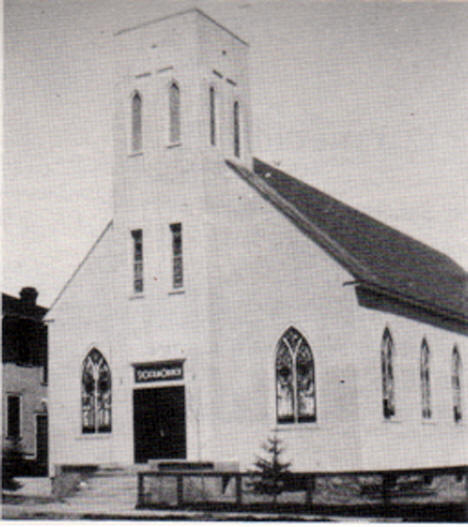
Old St. Cecilia's Church A Parish
Council was organized in 1967. First officers of the council
were Louis Stocco, president; Emil Schullo, vice-president;
Pat Raskovich, secretary; and Albert Borelli, treasurer.
Present officers of the Parish Council are Gary Brooks,
president; Kenneth Young, vice-president; and Maria Kautto,
secretary. The
greatest event in the history of the Catholic Church in
Nashwauk actually took place in Rome. At the Second Vatican
Council (1962-1965) the bishops of the world promulgated
documents which affected churches throughout the world. As a
result, rituals for the sacraments were revised, English
took the place of Latin, the church became viewed as "the
people of God,"; the involvement of lay people in the church
work was emphasized, there was a more tolerant or ecumenical
approach toward other churches and many laws were modified
or revoked. The effect was a period of change, insecurity
and re-evaluation which is still being experienced by
parishioners of St. Cecilia's. The Church will never be the
same as it was in the first half of the 20th century when
the village of Nashwauk was built by hardy immigrants and
their children on the western end of the Iron Range.
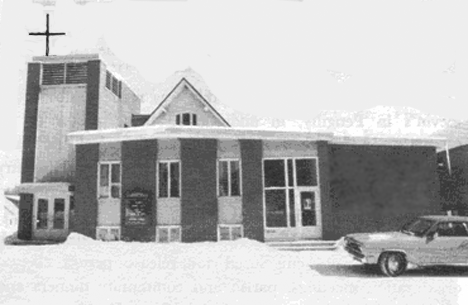
Nashwauk Lutheran Church
Nashwauk Lutheran Church Lutheran
Church work began in Nashwauk on Sunday, April 19, 1925,
with services at 8:00 p.m. in the old Finnish church on
upper Third Street, with 51 worshippers in attendance.
Reverend Harold Farseth of Our Savior's Lutheran Church of
Hibbing conducted the service. Paul Johnson, choir director
of Immanuel Lutheran Church of Hibbing, sang a solo and
Martha Pearson (Mrs. Gunnar Schlander) was accompanist.
Marcus Rostvold, infant son of Mr. and Mrs. Arndt Rostvold,
was baptized. Services were held every other Sunday for a year.
Reverend Ebb of Immanuel Lutheran and Reverend Farseth took
turns in ministering to the Nashwauk group. A quartet - Mrs.
Charles Hagen, Mrs. Arndt Rostvold, Mrs. William Saccoman
and Miss Alma Weggum, sang at most of the services. In June 1926, J. Clifford Lysen, a student at Luther
Theological Seminary in St. Paul, came to take charge for
the next four months. Place of services was changed to the
Village Hall, then to the Unique Theater. Reverend Lysen was
ordained and became the first pastor. Need for a place of worship became necessary, so in
August of 1926 a committee composed of Ole Weggum, Harry
Olson, John Turunen, George Lord, and Paul Tweed, was
drafted to draw up a Constitution, and on April 8, 1927,
church body was incorporated and the name Nashwauk Lutheran
was chosen. The first officers were, A.L. Wigen, H.C. Wick,
Paul Tweed, C.A. Forsberg, Russell Trythall, John Turunen,
George Lord, Nels J. Nelson, Harry Olson, and Chester
Larson. In July, 1927, the lot on which the present church stands
was bought and building began. Only the basement was built
and served as the place of worship for several years. The
first services were held on November 18, 1928.
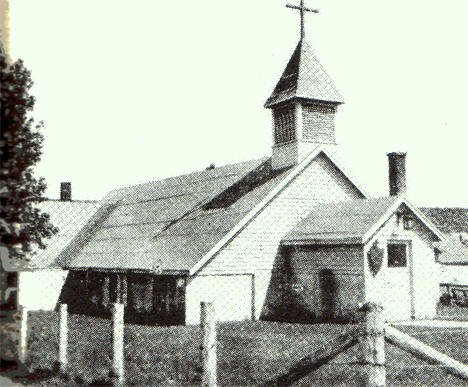
Basement of Nashwauk Lutheran Church 1928
In January, 1939, plans were made to build a super
structure. It was completed, and on December 25, 1940, the
first service was held. Dedication ceremonies took place on
May 11, 1941. With the growth of the congregation and Sunday School, it
became evident that more space was needed. Plans for an
educational unit were formulated and in 1958, the Louis
Strange property was purchased to be used for church
expansion. Building started in 1959, and was finished in
1960. 1962 saw a long hoped-for event for Nashwauk Lutheran.
For years the congregation had hoped for a full-time worker
the Lord. What would come out of it was that on June
17,1962, Luther Rostvold was ordained at a special service.
He is now serving in Philadelphia, Pennsylvania. Pastors who have served the congregation are: J. Clifford
Lysen, C.E. Nestande,C.J. Hanson, Sidney A. Rand, A.P.
Nassen, R.E. Bay, Donald Ofsdahl, Ronald Seedorf, and Eldon
Landvik, who is pastor at the present time. Others who have
served as interim pastors are: Harold Farseth, H.T.
Haagensen, Ingvold Hustvedt, and James Falk. David Steen
served as student pastor in 1959 and 1960. Nashwauk Lutheran celebrated its Fiftieth Anniversary in
April of 1977. Many who have moved away came home to help
make the celebration a big success. Active organizations within the church are the Sunday
School, Luther League, Campus Life, and the American
Lutheran Church Women. Present officers are: Claude Nelson, Charles Okeson, Fred
Ranger, Ann Krouse, Yvonne Mattson, Lyle Warwas, Fred
Toronto, Alden Judnitch, Robert Buescher, Florence Meuller,
John Haynes, Herbert Rowe, Dick Freidenberg, Larry Lake,
Richard Dal Canton, Lona Lokken, Susan Resch, Corrine Marsh,
and Eleanore Willman.
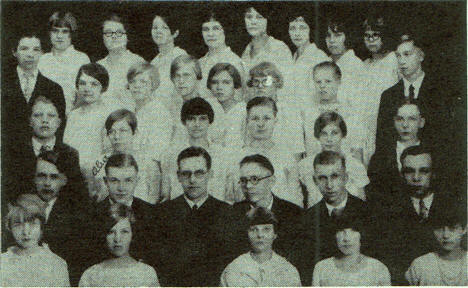
One of the First Lutheran Confirmation
Classes. First Row, L. to R.: Frances Hagen, Arlene Lord
Olga Johnson, Daisy Latvala, Eleanor Lofgren. Second row, L.
to R. Ray Nurkka, Clarence Hagen, Rev. Lysen, Wilbur Mattila,
John Berglund, Hans Nurkka. Third row, L. to R.: Ray Koski,
Alice Dahl, Agnes Johnson, Hendrickson, Elmi Salonen,
Eckstrom. Fourth row, L. to R.: Henry Johnson, Anna Johnson,
Florence Sumi, Sigrid Skoog, Eleanor Mattila, Rachel
Lappanen, Tuomala, Tauno Salonen. Fifth row, L. to R.:
Lappanen, unidentified, Hendrickson, Mrs. Hagen, Alma Weggum,
Emelia Forsberg, Eunice Koski, Melba Johnston
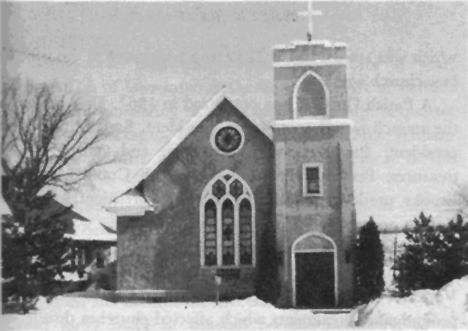
United Methodist Church
United Methodist Church The organization of Nashwauk Methodist Church dates back
to 1904. The first regularly conducted services were held in
the old school house on the north side of Nashwauk. Services
were held every Sunday afternoon with William Mudge,
Superintendent of the LaRue Mine, conducting. Mr. Mudge left
Nashwauk in 1906; Sunday School continued under the guidance
of Mrs. John Hudson, Mrs. Richard Williams, and Miss
Margaret Brown. A Ladies Aid was organized under the leadership of Mrs.
Charles West, with Mrs. Dodson as secretary. In the fall of 1906 a supply pastor, Mr. Hawkes, was
appointed to serve in Nashwauk. Those active at this time
were Mr. and Mrs. T.R. Dodson, W.A. Gordon, John Ohles, Carl
Lippincott, Archie McWilliams, Charles West, William Wivell,
Dr. Shellman, Andrew Berglund, Henry Hogan and the Mmes.
Margaret Brown, Edith Anderson, Ann Corserd, Elizabeth
Mowatt, Mr. John Lanto, and J.C. Lewis. In 1907 the Finnish Church was erected and the Methodist
Congregation was given permission to use it for their
services. Henry Hulme served as supply pastor at this time. The first Methodist Church was built in 1909 on the
corner of Fourth Street and was dedicated by district
superintendent, Clemens, cousin of Mark Twain. The first
choir consisted of Dr. and Mrs. Hewson, the Misses Laura
Manlin, Beatrice Thomas, Georgia Brown, Eda Jansig, Millie
Wivell, and Messrs. George Wivell, James Jensen, and John
Bartle. The next years saw a succession of ministers: Anthony
Doods, Ernes Parish, Fredrick Smith, John L. Parish, E.
Hunter, E. Ellis, V.G. Fellows, H. Bossaet, C.H. Muse, Otto
Baab, B.A. Williams, W.H. Downing. In 1928, while W.H. Downing was pastor the need for a new
church was felt. The Finnish Church was bought by the
Methodists and sold to Charles Latvia. They purchased the
tots on Third Street and Pearson Avenue from Mr. Latvala
where the present- church now stands. The building committee
included Julius Kuntz, X.E. Luiten, Stanley Mahon, Guy
Williams, C.J. Dicks, Dr. Weber, and Reverend Downing. The
trustees were: X.E. Luiten, Stanley Mahon, J.P. Raattama,
Julius Kuntz, Max Murray, J.E. Cannon, M.B. Rustan, Guy
Williams, and Horace Dearth. The church building was
dedicated October 14, 1928 Pastors serving Methodist Church since 1928 are: L.S.
Sloan, K.O. Brudevold, George Galbraith, Allyn Hanson,
Harold Symons, Reverend Prudham, C. Peterson, Floyd Cripps,
Calvin Hill, Charles Hawn, Bruce Erikson, Richard Kuhn,
Howard Amundson, John Newton, and Richard Vork who serves at
the present time. Nashwauk Methodist has produced one full time worker,
Gordon Orde, who was ordained June 4, 1975. He now serves
parishes at Wykoff and Fountain, Minnesota. This year, 1978, is Nashwauk's anniversary of the church
building. In 1979 the church will celebrate its diamond
jubilee. First Communion Class of 1911 at St. Cecilia's with
Father Quillian. Those who have been identified include
Lloyd Kolar, Peter Tarro, Rudolph Cloon, William Cloon,
Anton Podominick, John Briske, Frank Plutt, Louis
Bonovencini, Mary Pesevanto, Ellen Kennedy, Catherine Tarro,
Celestine Tarro, Mary Mayerle, Kate Sterbenz, Poida
Podominick, John Hughes, George Maurin.
|
Show me the way, not to fortune
and fame, not how to win laurels or praise for
my name — but show me the way to spread "The
Great Story" that "Thine is The Kingdom and the
Power and the Glory" - (Helen Steiner Rice). |
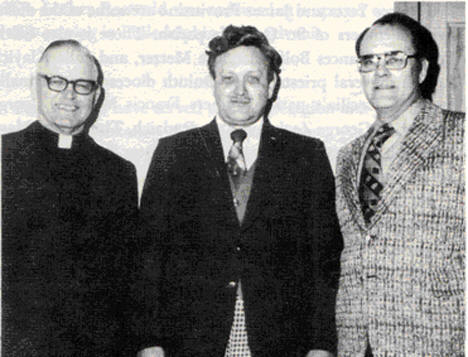
Pictured above are the three pastors of
Nashwauk's three churches: Left, Father Rudolph Pakiz, St.
Cecilia's; Rev. Richard Vork, United Methodist; Rev. Eldon
Landvik, Nashwauk Lutheran Church. |



